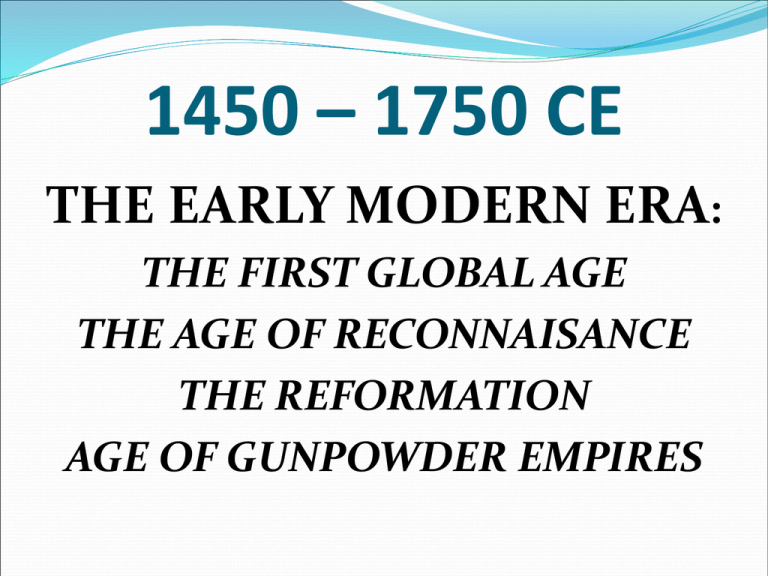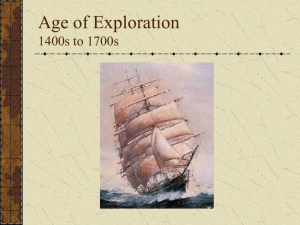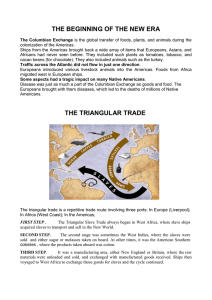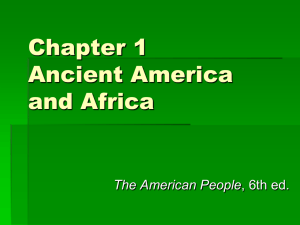THE EARLY MODERN AGE
advertisement

1450 – 1750 CE THE EARLY MODERN ERA: THE FIRST GLOBAL AGE THE AGE OF RECONNAISANCE THE REFORMATION AGE OF GUNPOWDER EMPIRES CAUSES OF PERIODIZATION 1450 End of the Middle Ages in Europe Beginning of the Northern Renaissance in Europe Globalization of Trade Conquest of the Byzantines Rise of Gunpowder Empires Contacts had expanded between Europe, Africa Increased trade contacts in the Indian Ocean Ottoman Empire, Ming China, Mughal India Rise of Russia (Moscow) Portugal, Spain, France Revolution in Technology Printing Press in Europe Navigation and military technologies Sub-Periods 1450 – 1600 Balance of Power between Spain, Portugal, Ottomans, Mughals, Ming, Qing 1600 – 1750 Tilting the Balance of Power: England, France, Netherlands, Russia WAYS TO VISUALIZE THIS PERIOD Great Man or Woman Theory One man or woman who is a visionary, influences age Henry the Navigator, Da Vinci, Luther, Louis XIV, Peter the Great, Elizabeth Akbar the Great, Abbas the Great, Tokugawa Iyeasu, Suleiman the Magnificent Culture is Import to Expansion The Influence of the Renaissance Economics drives the period Capitalism and mercantilism made the states wealthy Political Theory European state structure made their dominance possible International Trade Global Trade was dominated by the Europeans linking distance markets GUNPOWDER EMPIRES Gunpowder Empires Modern states supported by professional armies, navies Knowledge forced technological, industrial changes to traditional states Most states developed elite units around guns Mongols had spread knowledge to SW Asia, South Asia, Europe Successor states had used weapons to offset Mongol advantage in cavalry More important states all used modern armies to create, maintain states Examples Differentiate between land and maritime variants Europe: Portugal, Spain, England, France, Netherlands, Prussia, Russia Asia: Ottomans, Mughals, Safavids, Tokugawa, Ming and Qing China Africa: West African Forest Kingdoms, Mameluk Egypt, Morocco EMPIRE BUILDING Motivation Increased power, wealth motivated Europeans, Asians, Africans Europeans, Muslims often wanted to expand their faith Prestige for a ruler or a dynasty was also important Means Gunpowder, coercion The benefits accorded by stability, tradition: China Impediments Europe had little land to conquer, had to seek elsewhere Africans, Asians often lacked state structures to conquer All had to deal with other state structures in Afro-Eurasia Advantages European weaponry and maritime technologies Chinese could offer protection, stability to neighboring elites DYNASTIC POLITICS Dynastic Rule Predominant form of almost all states Inheritance of head of state passed within one family In Europe, Asia male primogeniture typical In Africa matrilineal male inheritance common Rivalries Marriage important to maintain image, retain land/property in family Marriages to increase prestige Seek to marry up, never down Women become pawns in marriage game = produce heir Dynastic Wars especially in Europe EUROPEAN STATE STRUCTURES Divine Right Monarchies Most use religion to justify their rule Divine Right Monarchy is not the same as Absolute Monarchies Bureaucrats loyal to the ruler Professionally trained as opposed to nobility Use of the new power of guns Use of new powers of taxation Many checks, balances on most European monarchs Use of a bureaucracy Constant struggle between monarchs and aristocracy for power Nobles, Church did not easily surrender their rights to monarchs Often associated with the rise of new cities, new classes Use of proto-nationalism to rally nation Constitutional Monarchies Parliaments represent different classes in society, check each other Constitutions passed by Parliaments restrict powers of rulers Colonial Empires Distance from mother country created defacto decentralization, feudalism ASIAN STATE STRUCTURES Absolutism Often called Oriental Monarchies Few real checks on a rulers’ power Assisted by bureaucracies, elite military units, elaborate ceremonies, hierarchies Feudalism Decentralized Europe, Southwest Asia, South Asia, Pre-Columbian Americas Notable Examples Old Shang, Zhou China were decentralized feudal monarchies In Western Europe – dying out due to monarchs (France, Germany) In Eastern Europe – newly introduced by monarchs (Poland, Russia) Vassals owed allegiance but autonomous in their own lands; nobles helped run state South Asia: Muslim landed elite, Hindu land owners controlled their own lands Southeast Asia: at center was monarch, vassals on periphery owed allegiance, tribute Centralized = East Asia Centralized state controlled distribution, inheritance of land Aristocracy was not used as bureaucracy – bureaucrats often from a different class Land owned by emperor, shogun: distributed to nobles, land is not hereditary All varieties threatened by commerce, monetary economy, towns, middle classes NEO-CONFUCIANISM Origins Blends Confucianism, Daoism, Buddhism Led to class division in China Men are good, but need education to improve themselves Even rulers need advice of well-educated advisors Social hierarchy critical – elites are always Confucians Hardening of the Five Relationships: Rank and Gender Distinctions Originated during Song, out of favor during Yuan Dynasty, revived by Ming Ming Dynasty Re-emergence of Scholar-Gentry as important in government Institutionalizing of the exam system, civil service examination, large/idle bureaucracy Military weakened at expense of scholar-gentry Restrictions on merchants and commerce Insistence on Tradition Anti-Western Attitudes Resented West – saw them as barbarians or infidels Cut themselves off from modern science, technological advances MUSLIM STATES All were examples of gunpowder empires Multi-National States With large non-Muslim populations Muslim elites ruling non-Muslim populations Generally – initially – tolerant to non-Muslim peoples Ottoman Empire Rise nearly ended by Tamerlane Turks, Sunni Muslim ruling Sunni, Shia Arabs, Christian Europeans Overruns SW Asia, battles Mameluk Egyptians, Safavid Persians Pushed to gates of Vienna, threatened Mediterranean Safavid Persians Persian, Shia Turkish Shia conquer Persia, begin conversions to Shia Islam Mughal India Originally Mongolic peoples from Central Asia Used gunpowder and elite troops to overcome large Hindu armies Came to embrace whole peninsula EUROPEAN NATION-STATES Nation-State A specific ethnic group (nation or people) Is the majority group within a state (it has boundaries) Dominates the government (state apparatus) Puts an ethnic stamp on state institutions Increasingly elite, common people shared a common culture, outlook Outgrowth of 14th century and 100 Years War English, French rivalry became increasingly nationalist Spain, Portugal arose as a result of Reconquista against Muslims Scotland defined itself in wars against England Dutch defined themselves religious, culturally against Spanish Reformation, Christian Sects strengthened nationalism Nation, State began to replace faith, God as center of allegiance WESTERN EUROPE Iberia: Portugal and Spain Dynastic States, Divine Right Monarchy Feudal structures still strong, nobles quite influential Manorialism strong, mercantilism minimal, no middle class France Centralized government, Divine Right Monarchy Legislative Body marginalized, nobles weakened Monarch surrounded by bureaucrats from middle class Economic System tended towards mercantilism England Constitutional monarch limited by law, advised by cabinet Strong Parliament, majority party rule Mercantilism and capitalism alternate, strong middle class EASTERN EUROPE All States were multi-national dominated by one ethnic group Southeastern Europe 1453: Constantinople falls to Ottomans Ottomans conquer Balkans, region up to Austrian border Development slowed by Ottoman controls Eastern Europe Poland Aristocratic Republic with Elected King: king absolutely weak Nobles control land, serfdom increased as agriculture rose in value Russia Moscow was most powerful principality in beginning Had to shake off Mongol rule first, then devoured rivals Struggle between Tsar, boyars for control; 1618 – New Dynasty THE INDIAN OCEAN India North Muslim Sultanate of Delhi Collapsed; Rise of Mughal Empire on Indus-Ganges Gradually pushed south conquering Hindu states Muslim minority had to learn to live with Hindu majority South Hindu Brahmin, Kshatriyan commercial states Southeast Asia Vietnam: Rise of Sinified State pushing down coast Khmer Empire replaced by rising Tai-Shan (Siamese, Thai) state Strong switch of religions Theravada replaces Mahayana Buddhism in Thailand, Indo-China Islam replaces Buddhism, Hinduism in Malaysia, Indonesia Europeans Portuguese, English, French, Dutch establish control over trade after 1500 SUB-SAHARAN AFRICA Sahel States Tributary State and Islamic Jihad cooperate to create states Mali replaced by Songhai by Kanem-Bornu Guns of Morocco disrupt region West African Forest States Arose based on commerce, slave trade Greatly strengthened by arrival of Portugal, weapons Rose, eventually destroyed by increase of slave trade Zimbabwe and Swahili States Tribute states, commercial states destroyed by Portuguese Ethiopia saved by arrival of Portuguese ASIA China Ming, Qing Dynasty Emperor isolated in Imperial (Forbidden) City Assisted by Confucian bureaucracy, isolated by eunuchs Rigid hierarchy, civil service different from landed elite Outlying regions, rival warlords, peasants dispute center Restricts western trade to Canton to limit influence Tokugawa Shogunate of Japan Kamakura Shogunate gives way to civil war between daimyo Tokugawa clan emerges victorious, establishes new shogunate Breaks power of clergy including Catholic priests Isolates country from western influence Hermit Kingdom of Korea: Independent, tributary to China THE AGE OF RECONNAISANCE Crusades and wealth of Muslims, East influenced age Crusading spirit strong in Iberia Merchants of Italy, Hansa want new trade routes Knowledge learned during Renaissance influenced age Astrolabe, compass New geographic knowledge New Ship Designs Rise of Nation-States encouraged competition Renaissance created curiosity, adventure IMPACT OF EXPLORATIONS In China, India; West Africa, SW Asia European influence limited by large populations, states In Africa, diseases made European colonization impossible Europeans able to earn trade concessions Established regular trade routes In Americas Europeans established colonial empires Subjugated local states, peoples Looted their wealth, exploited their land and labor On Europeans Price Revolution, e.g. Inflation Shifted Economic Power from Iberia, Mediterranean to North Sea states Rise of Capitalism and bourgeoisie Loss of power of feudalism, feudal aristocracy; rise of absolute monarchs Introduction of new food stuffs, spread of diseases EUROPEAN COLONIAL EMPIRES Settler Colonies Europeans immigrate, settle lands, try to recreate “mini-Europes” European immigrants, Europeans born in Americas dominate hierarchy Large Indian populations in much of Latin America Empires Portugal: Brazil Spain: Mexico, Central America, Andean America, American West, Florida, Cuba France: St. Lawrence River Valley, Mississippi River Valley, Caribbean islands (Haiti) England: Hudson Bay, Atlantic Seaboard, Jamaica, Caribbean islands New Social Structures Class system peculiar to colonies Europeans (peninsulares) dominate colonial government Local Born Europeans (creoles) dominate commerce, land Latin America: Mixed Populations (Indian, European) Latin America: Mulatto (Indian/Black, European/Black) Both Americas: Native Americans but marginalized Both Americas: Slaves but marginalized CHANGE & CONTINUITY Trade and Commerce Europeans entered trade as major players for first time But China, India, Muslims did not lose control to Europe Americas Spain destroyed states, societies of Amerindian civilizations Spain created a new casted society with different elites But Spain transplanted its feudal institutions to run empire Social Patriarchy continues, European women accorded some gains Aristocracy still around but weakened by rising bourgeoisie Feudal nobles weakened as centralized monarchy emerges WESTERNIZATION OR MODERNIZATION Westernization Imitating the west, its institutions Usually meant Europeanizing your culture Modernization Modernizing your state, its institutions to compete Technological improvement, military Avoid culturally copying, mimicking the Europeans European culture conflicted with local traditions The two are not the same and should not be confused! PETER THE GREAT’S RUSSIA Russia Isolated due to Mongols, Ottomans, Poland, Sweden Cut off from contacts with the west Tsar’s powers limited by Church, boyars (nobles) Modernization meant Westernization European your culture, calendar, society Make nobles dress, act, speak like European nobles Model your state apparatus after Europeans Move capital from Moscow to St. Petersburg Limit power of boyars, church: absolute monarchy Build Western Industry, Western-like military Create navy (Dutch, English); create army (Germans) Attract trade from western nations: Dutch, English Create an Empire by attacking Poland, Turks, Swedes OTTOMAN EMPIRE: TURKEY Create an empire through the military Modern weapons Elite military units: Janissaries Recruited through the boy tax (devishirme) on Christians Boys raised as Muslims for military, bureaucracy Army supported by feudal cavalry levies Built fleet manned by Europeans (Greeks) Conquered diverse lands Southeastern Europe up to Vienna Southwest Asia and North Africa No urgency to Westernize or Modernize Ignored trade, commerce, elites, tax structures Allowed minorities (Greeks, Armenians, Jews) great influence MUGHAL INDIA Semi-Nomadic Conquerors of India Related to the Mongols, hence the name Sunni Muslims from Central Asia Tribute Empire Left local decisions in hands of local elites Muslim elite in the north Hindu elites throughout the empire but middle, south Simply wanted their taxes paid on time, prestige Welcomed foreign merchants ideas Allowed Europeans to trade throughout land Europeans meddled, seized control of trade Never saw Europeans as threat until too late MING/QING CHINA Neo-Confucianism Air of False Superiority Xenophobia about contacts with, foreign items, ideas Mindset made it difficult to reform, change Treaty Ports Limited Europeans to trade at one port: Canton Seclusion Limited contacts between Chinese, Westerners Their military made it too difficult for Europeans to control Japan similar under Tokugawa Shoguns Japan limited contacts to one ship, one port (Nagasaki) ECONOMIC SYSTEMS Traditional Favors agriculture, little to no innovation, use of old labor intensive formats Profit was small to non-existent, traditional elites did it the way they had always done it Very little to no trade, subsistence production, low on capital, technology Autarky was goal, self-sufficiency Command Economy Centralized system dictates production, sets prices, regulates all aspects of economy Feudalism is a blend of traditional and command economy Maintain status quo, role, rights of aristocracy, nobility Serfdom, slavery, encomiendas, mita all parts of tradition Competition restricted, middle classes discouraged Very decentralized functions, state had little influence over most local economic decisions Free Market Economy An Example - Capitalism: States which developed great trade, industry New development during period: in England, Netherlands State’s sole roles were to make market safe, protect individuals earnings State had limited, restricted role in interfering in markets Middle classes, successful individuals rewarded under system Most states were a mixed variation MERCANTILISM Mercantilism: Most Major States Supported This Form State regulates trade with taxes, tariffs State supports enterprises which benefit nation Regulates trade to maintain monopolies, avoid competition State active participant in commerce Make profits, maintain positive balance of trade: Gold, Silver, luxuries most important Want to produce finished goods and sell them to less developed nations All European colonies functioned under this system Limited Liability Companies, Charter Companies The East India Companies of the English, Dutch, French Chartered by state who took a percentage of the profits Most profits went to those who bought stock, took risks, invested China: Looks down upon merchants, regulates trade, trade through Canton only Japan: Ditto through Nagasaki India: trade regulated under licenses but great competition, rivalry Western Europe, Eastern Europe, Americas: Dominated by mercantilism Southeast Asia: trade regulated under licenses but great competition, rivalry Muslim lands: trade often in a minorities’ hands, few native merchants ROLES OF WOMEN Status of Women Higher up the Social Status of Women More freedom to engage in arts, education Servants did work for elite women More social mores and restrictions common: women protected More likely to be secluded in many cultures Lower the Social Status of Women Women had to work in fields AND house raising family Lower class women more valued, freer as their contribution critical to life Cities and Commerce Change Status Both opened up opportunities to learn crafts, run a business Especially true in England, France, Netherlands, Germany North American English, French, Dutch colonies Women had great freedom as old country society did not transplant ROLES OF WOMEN In China, Korea, Japan Confucianism governed family relationship Neo-Confucianism very misogynistic: Obey fathers, husbands, sons: always subservience Chinese employed foot-binding to restrict freedom Japanese women painted faces In Arab and Persian Muslim Societies Harem - women separated from rest of house, world Veiling - to cover face when in public; later had to cover all exposed flesh In South Asia Muslim restrictions learned from South Asia Child Marriage: young girls married to older men Widow Burning: suttee European Women Subject to Change Due to Commercial Revolution, Renaissance, Enlightenment Reformation both helped and hindered women’s progress African Women Sub-Saharan women often ignored Muslim restrictions Women had to assume new roles in societies once slaving occurs (“take over from men”) EARLY SLAVERY Slavery Not a new concept: all societies had had it Often prisoners of war, payment for debts, criminals Race was not part of the original conditions African Slave Trade To Mediterranean from West Africa To SW Asia from East Africa Originally controlled by the Swahili until Portuguese took control After fall of the Portuguese, Swahili and Sultan of Oman controlled trade Mameluks (Turks, Mongols) used slaves as soldiers Two most common uses for slaves Domestic Slaves: in house Field or Mine Slaves: laborers, workers in the fields, mines Arrival of Portuguese Redirected trade to Atlantic islands, Europe Controlled trade on the seas for profit TRANSATLANTIC SLAVE TRADE Trans-Atlantic Slave Trade originated in 16th century Spanish, Portuguese grew sugar in Canaries, Azores: used African slaves Sugar eventually transplanted to Caribbean along with need for slaves Spanish originally used Indians until supply ran out; tapped African supply Need for slaves to do Labor-Intensive work Plantations Mining Locations of Plantations Grew Cash-Crops for export in hot, low-land areas of Caribbean Caribbean: Grew Sugar North American (Southern Colonies) Colonies: Rice, Sugar, Indigo, Tobacco First slaves arrived in Virginia in 1619 CE Treated as indentured servants at first but need for slaves changed system Brazil: First Sugar, cocoa, coffee TRIANGULAR TRADES Triangular Trade Europe produced finished goods for trade, profit European colonies produced cash crops, materials for export, but needed slaves West Africa had a surplus of slaves but wanted finished goods The Passage of Slaves Across the Atlantic called “Middle Passage ” African kings, states caught, collected slaves to sell to Europeans Europeans (Dutch, Spanish, Portuguese, English) transport Africans to Americas 20 million Africans transported to Americas but up to 50% died from port to port Institutionalized Slavery Europeans needed cheap supply of labor of male laborers They came to view Africans as uncivilized, less than Europeans Mortality of Africans in Caribbean, Brazil was extremely high Only North America had a self-perpetuating African population Slavery on plantations not as dangerous American colonies also included women in slave trade for domestic help American Slaves and “Rights” Slaves had no rights, privileges; could be sold away at will of owner; could not teach to read, to write Marriages were not recognized, children born of slaves were slaves Slaves could not own property, they were property (Chattel slavery); no protections from owners CONSEQUENCES OF TRADE Consequences of Trade for Africa Some areas were depopulated in effort to acquire slaves Healthiest Africans captured leaving old, infirm to care for self Slave raids captured whole cross-sections of society including leaders Failure of Arts, Technology to develop as best, brightest included in trade Other types of trade declined as slaves became most lucrative trade commodity Sudanic States lost importance as commerce shifted to African forest states Growth of African forest states in power Spread of guns in exchange for slaves Need for guns perpetuated slave trade, slave raiding, warfare Racism developed to justify trade Other forms of unfree labor in Americas Common in Latin America Encomienda, Mita: Forced labor like European corvee Peonage: Service until debt is paid off Common in Southern United States after Slavery abolished Tenant Farming, Sharecropping: farm other peoples’ lands, pay in produce ABOLITION Connections to 1750 - 1914 Enlightenment included abolition of slavery Methodism founded in early 18th century strongly opposed to Slavery A Product of Revolutions Danes, Dutch, French abolish slavery between 1790s and 1810s British abolish slave trade in 1807 and slavery in 1833 US abolishes external slave trade in 1808 Haitian Revolution (1794 - 1804) abolishes slavery Latin American independence revolutions usually ended by abolishing slavery US Civil War ends slavery In 1863 (Emancipation Proclamation) In 13th - 15th Amendments to Constitution Brazil ends slavery in 1888 and slave owners abolish empire in 1889 UN Declaration of Human Rights in 1948 condemns slavery Only a few Muslim lands still tolerate slavery (Quran permits) today EXCHANGES, MOVEMENTS Columbian Exchanges Peoples, plants, animals, microbes, ideas, technologies Began with discovery of Americas, trade with Africa, Asia Exchanges as part of movement, commerce Exchanges both global and reciprocal: no region not involved Urbanization is a rural to urban movement Trade or Commerce is always an example of exchange This era is the first global age especially of trade African Slave Trades are examples of exchanges, movements European colonization of Americas is an exchange, movement Russian colonization of Siberia by Cossacks, farmers, criminals Chinese settlement, opening of marginal lands DEMOGRAPHIC CHANGES A Result of Columbian Exchanges, Empire Building in Americas China - population doubled from 1400 to 1800 (80 to 160 million) Brought more land under cultivation Introduced new crops (rice), new world crops Japan: improved farming techniques, increased yields Western Europe 1700: 100 million to 1800: 190 million Introduction of new techniques, new crops including potatoes Africa had a demographic stagnation due to Slave Trade: no natural increase Urbanization: Especially in Western Europe, China, Japan Drew ambitious people from countryside Center of commerce, trade Internal movement to cities during famines, enclosures Demographic Shift A massive change in structure, nature of population (first since Neolithic Revolutions) In Americas due to disease: dropped from 250 million in 1500 to 10 million in 1650Europeans, mixed populations, livestock replaced Indians REFORMATIONS Reformations Protestant Reformation Disputes were Major Players: Luther, Calvin, Knox, Henry VIII Three Common Protestant principles Secular (hierarchy, politics, marriage, land ownership) Religious (doctrines, celibacy, quality of priests, sacraments) Bible is absolutely true as written Priesthood of all believers (do not need popes, priests) Salvation by faith alone (no part played by tradition, indulgences) Catholic Reformation Began earlier than Luther with Imperial reforms, people such as Erasmus of Rotterdam Gained strength during Protestant Reformation as need to counter their issues Culminated in the Council of Trent Reforms Results Bible translated into vernacular helped spread literacy Supported princes in many lands fueling nationalism Divided church, nations, caused many wars, civil wars Church stripped of land, authority in many states Fueled anti-clericalism in some states Stimulated rise of middle class, which supported many of the Protestants THINKING REVOLUTIONS Renaissance expanded from Italy: 1450 - 1610 Northern Renaissance in England, France, Germanies Emphasized science, math, Old Testament, Hebrew more Christian Humanism was stronger Impacted arts too but art more religious than secular Erasmus, King James Bible, Shakespeare, Rabelais Scientific Revolution: 1500s to 1700s Part of the Renaissance but went beyond its foundations Natural Science, Scientific Method of Observation Moved away from Medieval understandings Relied less on supernatural explanations of earthly phenomena Galileo, Copernicus, Kepler, Newton Brought many into conflict with Catholic Church Enlightenment: Science, Natural law, Human Reason govern human nature Began in early 1700s with insistence on rationalism, human progress More than a social, intellectual, political critique, reform of society Concerned with applying science, learning to better society Called for an end to injustice, superstition, inequality, reform of institutions Or Not? Asia, Muslims reject Western learning preferring own forms, traditions South Asia, Russia, Eastern Europe only regions to adopt some European traditions European Art Medieval: Based on Faith, God with little attention to individuality Renaissance AND THE ARTS? Attention to secular, wealthy, mythology, everyday life, human figure, individuality became important Realism, perspective as opposed to idealism, religion emphasized Baroque, Rococo Followed Both dealt with embellishment, power, authority, wealth: Versailles, St. Petersburg represent this ideal China and Japan Building of the Forbidden City: Ming Dynasty emphasized old styles, denied innovation Kabuki (musical drama), Haiku (syllabary poetry), Bunraku (puppet plays) All represent non-elite entertainments spread to all classes India Merger of Muslim, Persian, Indian styles; Taj Mahal, miniature painting Russia Introduction of Italian, West European styles to Russia: fusion, synthesis West Africa Lost-wax casting method brought bronzes to height of perfection Contacts with Portuguese introduced European motives to African art Latin America: Spanish tradition began to synthesize with Indian motifs Compare and contrast state structures of one European and one Afro-Asiatic empire; France Portugal Spain England Holland Russia Austria Ottoman Empire Safavid Empire Mughal Empire Ming Chinese Empire West African Forest State West African Sahel State Japanese Shogunate Compare Russia’s interactions with the West with the interaction of any one of these with the Europeans: Ottoman Empire, Mughal India, Ming/Ching China, and Tokugawa Japan. Compare and contrast systems of gender and social inequalities n the Early Modern Age in any two countries, one European or European colonial empire and one nonEuropean state. Compare economic systems and commerce of any two nations, one European and one non-European during the Early Modern Age. Compare the process of empire-building of one European and one Afro-Asiatic empire (gun-powder empire); France Portugal Spain England Holland Russia Austria or Prussia Ottoman Empire Safavid Empire Mughal Empire Ming Chinese Empire West African Forest State West African Sahel State Japanese Shogunate Compare and contrast any two coercive systems of labor Caribbean Slavery Slavery in the English North American colonies Slavery in Brazil Spanish Mita system in South America West African slavery Muslim slavery in S. W. Asia India Hindu castes East European serfdom





